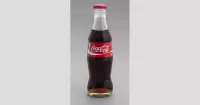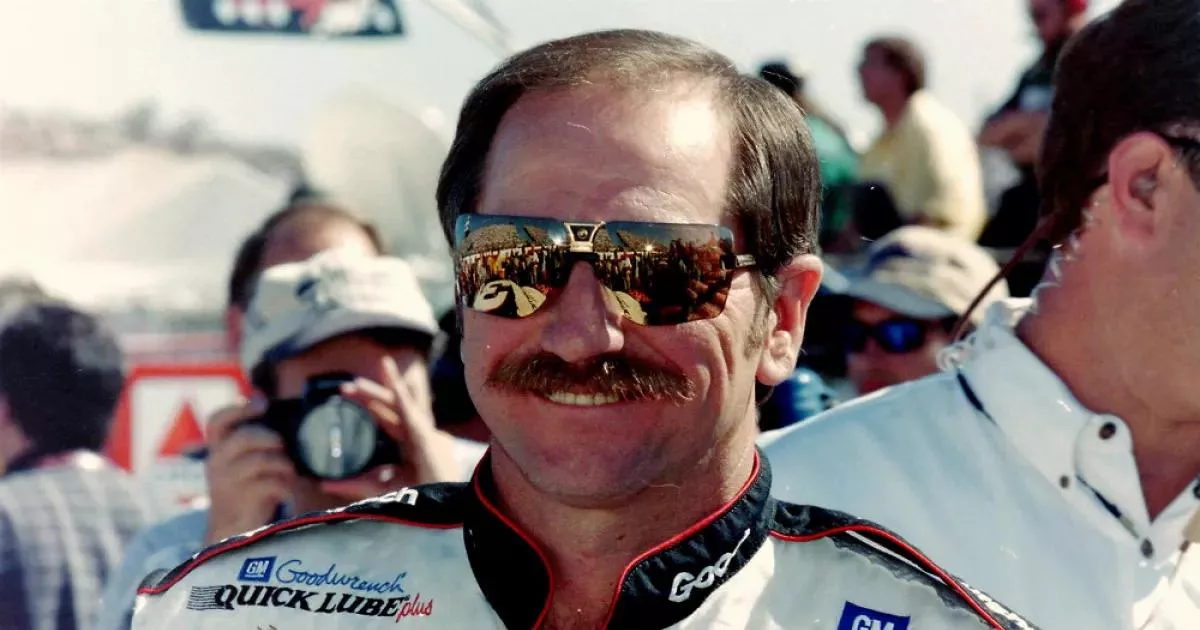"The Intimidator," "The Man in Black," or "Ironhead" as he was known to his fans, was an American professional stock car driver and racing team owner. Ralph Dale Earnhardt raced from 1975 until his death in 2001. He is remembered as one of the greatest drivers in NASCAR history for his aggressive driving style, most notably in his black number 3 Chevrolet for Richard Childress Racing. In 1998, he was named one of NASCAR's 50 Greatest Drivers and continues to be celebrated as a legend in the sport.
1928: Birth of Ralph Earnhardt
Dale Earnhardt's father, Ralph Earnhardt, was born in 1928.
1930: Birth of Martha Earnhardt
Dale Earnhardt's mother, Martha Earnhardt, was born in 1930.
April 29, 1951: Birth of Dale Earnhardt
Dale Earnhardt was born on April 29, 1951, in Kannapolis, North Carolina.
1956: Ralph Earnhardt's NASCAR Sportsman Championship
Dale Earnhardt's father, Ralph Earnhardt, won his first and only NASCAR Sportsman Championship in 1956 at Greenville Pickens Speedway.
1956: Ralph Earnhardt's Racing Career
The throwback car driven by Dale Earnhardt Jr. in 2006 was inspired by the dirt cars Ralph Earnhardt raced in 1956.
1960: David Pearson Wins Rookie of the Year and Winston Cup Series Championship
David Pearson became the first driver in NASCAR history to follow a Rookie of the Year title with a NASCAR Winston Cup Championship in 1960.
1963: Dale Earnhardt's First Drive
At age 12, Dale Earnhardt secretly drove his father's car in one of his races in 1963 and almost won.
1964: Richard Petty Wins Winston Cup Series Championship
Richard Petty won his first NASCAR Winston Cup Championship in 1964.
1966: David Pearson's Second Championship
David Pearson won his second NASCAR Winston Cup Championship in 1966.
1968: First Marriage to Latane Brown
Dale Earnhardt married his first wife, Latane Brown, in 1968.
1970: Divorce from Latane Brown
Dale Earnhardt and his first wife, Latane Brown, divorced in 1970.
1971: Second Marriage to Brenda Gee
Dale Earnhardt married his second wife, Brenda Gee, in 1971.
1972: Birth of Kelley King Earnhardt
Dale Earnhardt's first daughter, Kelley King Earnhardt, was born in 1972.
1972: Dale and Ralph Earnhardt Race Together
In 1972, Dale Earnhardt raced against his father, Ralph Earnhardt, at Metrolina Speedway.
1973: Death of Ralph Earnhardt
Dale Earnhardt's father, Ralph Earnhardt, died in 1973.
1974: Grand National Debut
Dale Earnhardt made his Grand National debut in 1974 at an exhibition race at Metrolina Speedway.
1974: Birth of Dale Earnhardt Jr.
Dale Earnhardt's first son, Dale Earnhardt Jr., was born in 1974.
1975: First Race in the World 600
Dale Earnhardt began his professional career in 1975, debuting at the World 600 at Charlotte Motor Speedway.
1975: Start of NASCAR Winston Cup Series Career
Dale Earnhardt began his professional career in the NASCAR Winston Cup Series in 1975.
1975: First Points Race
Dale Earnhardt made his points race debut in the World 600 at Charlotte Motor Speedway in 1975.
1979: Continued Racing
Dale Earnhardt competed in eight more races until 1979.
1979: First Career Win
Dale Earnhardt won his first race in 1979.
1980: Dale Earnhardt's First NASCAR Cup Series Championship
In 1980, Dale Earnhardt secured his first ever NASCAR Cup Series championship win.
1981: Earnhardt Adopts No. 3 Car
Dale Earnhardt began driving the No. 3 car in the latter part of the 1981 NASCAR season.
1981: Driving for Different Teams
Dale Earnhardt drove for both Jim Stacy and Richard Childress Racing in 1981.
1982: Driving for Bud Moore
Dale Earnhardt joined car owner Bud Moore for the 1982 and 1983 seasons.
1982: Third Marriage to Teresa Houston
Dale Earnhardt married his third wife, Teresa Houston, in 1982.
1983: Return to Richard Childress Racing
Dale Earnhardt returned to Richard Childress Racing in the No. 3 car after the 1983 season.
1983: First Twin 125 Daytona 500 Qualifying Race Win
Dale Earnhardt won his first of 12 Twin 125 Daytona 500 qualifying races in 1983.
1984: Start of Two Year Streak
Dale Earnhardt began a two-year streak with Richard Childress Racing during the 1984 and 1985 seasons.
1984: Dale Earnhardt's Iconic Wrangler Car
In 1984, Dale Earnhardt drove the iconic Wrangler car, which would later be driven by Daniel Ricciardo in 2021 as a tribute to Earnhardt.
1984: Earnhardt Returns to No. 3 Car
In 1984, Dale Earnhardt resumed driving the No. 3 car, which he continued to pilot until his passing in 2001.
1984: Terry Labonte's First NASCAR Cup Series Championship
In 1984, Terry Labonte won his first NASCAR Cup Series championship title.
1984: Rusty Wallace Wins Rookie of the Year
Rusty Wallace won Rookie of the Year in 1984.
1985: End of Two Year Streak
Dale Earnhardt finished his two-year streak with Richard Childress Racing at the end of the 1985 season.
1986: Alan Kulwicki Wins Rookie of the Year
Alan Kulwicki won Rookie of the Year in 1986.
1986: Second Winston Cup Championship and First Owner's Championship
In 1986, Dale Earnhardt won his second Winston Cup Championship and secured the first owner's championship for Richard Childress Racing. This successful year saw him win five races, achieve 16 top-five finishes, and 23 top-ten finishes.
1987: Third Winston Cup Championship, "The Intimidator" Nickname, and "Pass in the Grass"
The 1987 season was significant for Earnhardt. He won his third Winston Cup Championship, solidifying his place as a racing legend. His aggressive driving style earned him the nickname "The Intimidator," particularly after the 1987 Winston All-Star Race. In this race, he executed the famous "Pass in the Grass" maneuver, where he drove through the infield grass without losing his lead. This season was also marked by a death threat that led to FBI protection for Earnhardt at three races.
1988: Birth of Taylor Nicole Earnhardt
Dale Earnhardt's second daughter, Taylor Nicole Earnhardt, was born in 1988.
1988: New Sponsor, New Look, and Third-Place Finish
In 1988, Earnhardt began racing with a new sponsor, GM Goodwrench, and his car's paint scheme changed to the iconic black No. 3. He won three races and finished third in the points standings.
1989: Five Wins and a Near Championship
In 1989, driving the GM Goodwrench Chevrolet Lumina, Earnhardt won five races. A late spin out at North Wilkesboro cost him the championship, with Rusty Wallace edging him out by 12 points.
1989: Rusty Wallace Wins Winston Cup Series Championship
Rusty Wallace won his first NASCAR Winston Cup Championship in 1989.
1990: First Winston 500 Win
Dale Earnhardt won his first Winston 500 in 1990.
1990: Fourth Winston Cup Title and First Multiple Winner of The Winston
Earnhardt's 1990 season was marked by a heartbreaking loss at the Daytona 500 after leading for most of the race. Despite this setback, he won nine races, secured his fourth Winston Cup title, and became the first multiple winner of The Winston all-star race.
1991: Fifth Winston Cup Championship and Victory at North Wilkesboro
In 1991, Earnhardt clinched his fifth Winston Cup championship. A notable victory came at North Wilkesboro, where he prevented Harry Gant from breaking his record of five consecutive wins.
1992: Alan Kulwicki Wins Winston Cup Series Championship
Alan Kulwicki won his first NASCAR Winston Cup Championship in 1992
1992: A Challenging Year and Crew Chief Change
The 1992 season was a challenging one for Earnhardt. He finished a career-low 12th in the points standings, marking the second time he had finished that low since joining Richard Childress Racing. This disappointing result prompted a crew chief change, with Andy Petree replacing Kirk Shelmerdine.
November 14, 1993: Sixth Winston Cup Title and a Tribute to Fallen Drivers
Earnhardt's fortunes changed in 1993. With Andy Petree as his crew chief, he returned to form, winning six races and securing his sixth Winston Cup title. This included wins at the Coca-Cola 600, The Winston, and the Pepsi 400. Following the season-ending Hooters 500, Earnhardt and Rusty Wallace honored deceased drivers Davey Allison and Alan Kulwicki with a touching tribute lap.
1993: Dominating Speedweeks and Daytona 500 Finish
Dale Earnhardt began the 1993 season by dominating Speedweeks. However, he finished second to Dale Jarrett in the Daytona 500.
1993: Jeff Gordon Wins Rookie of the Year
Jeff Gordon won Rookie of the Year in 1993.
1994: Second Winston 500 Win
Dale Earnhardt won his second Winston 500 in 1994.
1994: Seventh Winston Cup Championship and a Tie with Richard Petty
In 1994, Earnhardt achieved a historic milestone by winning his seventh Winston Cup championship, tying the legendary Richard Petty. This was a testament to his consistency throughout the season, which saw him secure four wins and ultimately clinch the title by a significant margin.
1995: Almost Leaving the #3 Team
At the end of the 1995 season, Earnhardt contemplated leaving Richard Childress Racing and his iconic #3 car. Robert Yates, owner of the #28 Ford Thunderbird, had approached Earnhardt to drive for him, but the deal fell through as Earnhardt only wanted to drive the #28 car, which Yates intended to return to Ernie Irvan upon his recovery.
1995: Last Short Track Win
In 1995, Dale Earnhardt secured his last short track victory at Martinsville.
1995: Jeff Gordon Wins Winston Cup Series Championship
Jeff Gordon won his first NASCAR Winston Cup Championship in 1995.
1995: Second Place Finish, First Road Course Victory, and Brickyard 400 Win
The 1995 season saw Earnhardt finish second in the championship standings, narrowly losing out to Jeff Gordon. Despite the near miss, he achieved notable victories, including his first road course win at Sears Point and a memorable triumph at the Brickyard 400.
1996: Recovery, Determination, and the "True Grit" Pole
Following his crash at Talladega in 1996, Earnhardt refused to let his injuries sideline him. He returned to racing at Indianapolis and Watkins Glen, where he qualified for the pole position, earning the nickname "True Grit." Despite not winning again that year, he finished fourth in the standings.
1996: Return to Form and Near Miss
In 1996, Dale Earnhardt showed glimpses of his old form, particularly in the August race at Michigan, where he led laps late in the race and came close to winning his first non-restrictor-plate race since 1996.
1996: Near-Fatal Crash and Championship Pursuit
In 1996, Dale Earnhardt was in contention for his eighth season title. However, on July 28th, during the DieHard 500 at Talladega, he was involved in a serious crash that resulted in his car hitting the wall head-on at high speed. Despite a broken collarbone, sternum, and shoulder blade, he refused to be loaded onto a stretcher.
1997: A Winless Season and Health Concerns
The 1997 season marked only the second time in Earnhardt's career that he went winless. He experienced a health scare during the Mountain Dew Southern 500 at Darlington when he blacked out and hit the wall. Despite these setbacks, he finished fifth in the final standings.
February 15, 1998: Daytona 500 Victory and Season Performance
On February 15th, 1998, Dale Earnhardt finally won the Daytona 500 in his 20th attempt. His victory was followed by a massive show of respect from fellow competitors and a memorable celebration in the infield grass. This win marked his only victory of the season.
1998: NASCAR's 50 Greatest Drivers
Dale Earnhardt was named as one of NASCAR's 50 Greatest Drivers in 1998.
1998: Earnhardt's Helmet Displayed
Dale Earnhardt's helmet from the 1998 season is on display at the National Museum of American History in Washington D.C.
1998: Earnhardt's Daytona 500 Victory
The 2008 throwback car commemorated the 10th anniversary of Dale Earnhardt's victory in the 1998 Daytona 500.
1999: Age, Speculation, and Controversial Win
As Earnhardt's career progressed, discussions about his age and potential retirement began circulating, especially with his son's debut in the Winston Cup. However, he continued to compete, securing victories at Talladega and sparking controversy with a last-lap bump to win at Bristol.
1999: Dale Earnhardt Jr. Joins Cup Series
Dale Earnhardt became known as Dale Earnhardt Sr. when his son, Dale Earnhardt Jr., joined the Cup Series circuit in 1999.
1999: Third Winston 500 Win
Dale Earnhardt won his third Winston 500 in 1999.
1999: Tony Stewart Wins Rookie of the Year
Tony Stewart won Rookie of the Year in 1999.
2000: Fourth Winston 500 Win
Dale Earnhardt won his fourth Winston 500 in 2000.
2000: Resurgence and Exciting Wins
In 2000, Dale Earnhardt experienced a resurgence in his racing career, widely attributed to neck surgery he underwent to address a lingering injury from a 1996 crash at Talladega. He secured two thrilling victories that year, winning by a mere 0.010 seconds over Bobby Labonte at Atlanta and making a remarkable comeback at Talladega, where he gained 17 positions in the final four laps to claim his 10th win at the track and the No Bull million-dollar bonus.
2000: Matt Kenseth Wins Rookie of the Year
Matt Kenseth won Rookie of the Year in 2000.
February 18, 2001: Death of Dale Earnhardt
Dale Earnhardt died on February 18, 2001, at the age of 49 in a last-lap crash during the Daytona 500.
February 19, 2001: Autopsy and Cause of Death
An autopsy conducted on February 19, 2001, revealed that Dale Earnhardt's death, following a crash at the Daytona 500 on February 18, 2001, was caused by a fatal basilar skull fracture.
February 21, 2001: Private Funeral and Burial
Following a private funeral service on February 21, 2001, Dale Earnhardt was laid to rest at his estate in Mooresville, North Carolina.
2001: Earnhardt's Passing and Legacy of the No. 3
Dale Earnhardt's tragic death in 2001 cemented the legacy of the No. 3 car, forever linked to his name and his iconic black and red paint scheme.
2001: Dale Earnhardt, Inc. Success and Poignant Daytona Finish
Dale Earnhardt, Inc. (DEI) achieved five victories during the 2001 NASCAR season. The wins included Steve Park's victory at Rockingham, just a week after Earnhardt's passing, and a poignant 1-2 finish by Dale Earnhardt Jr. and Michael Waltrip at the Pepsi 400 in Daytona, a reversal of their finishing order in the Daytona 500 where Earnhardt Sr. tragically lost his life.
2001: Childress Racing's Priority Use of No. 3
Despite a common misconception, Richard Childress Racing did not own the rights to the No. 3 in NASCAR. However, they held priority to reuse the number following Dale Earnhardt's death in 2001.
2001: Tributes Following Earnhardt's Death
Following Dale Earnhardt's death in 2001, fans paid tribute by raising three fingers.
2001: Kevin Harvick Replaces Earnhardt
Following Dale Earnhardt's death, Kevin Harvick, a second-year Busch Series driver for Richard Childress Racing, was chosen to replace him, starting with the 2001 Dura Lube 400 at North Carolina Speedway. The team was renamed No. 29, and Harvick's car featured the stylized No. 3 on the "B" posts as a tribute to Earnhardt.
2001: John Hiatt's Song Mentions Earnhardt
John Hiatt's 2001 song "The Tiki Bar Is Open" mentions Dale Earnhardt and his race number.
2001: Kevin Harvick Wins Rookie of the Year
Kevin Harvick won Rookie of the Year in 2001.
2001: Harvick's First Win and Emotional Tribute
Three weeks after Dale Earnhardt's death, Kevin Harvick, driving a car originally prepared for Earnhardt, secured his first NASCAR Cup Series victory at Atlanta Motor Speedway. The emotional win, with a margin of victory reminiscent of Earnhardt's win at the same race the previous year, included poignant imagery of Earnhardt's longtime gas man, Danny "Chocolate" Myers, overcome with emotion, and Harvick raising three fingers in tribute during his victory burnout.
2002: Dale Earnhardt Jr.'s Special Appearances
In 2002, Dale Earnhardt Jr. made two special appearances in a No. 3 Busch Series car at Daytona and Charlotte, winning the season-opening event at Daytona.
2002: NASCAR Honors Earnhardt
In the wake of Dale Earnhardt's death, NASCAR paid tribute to him in various ways, including observing a moment of silence during the third lap of races from Rockingham until the following year's race at the same track, unless caution flags were necessary.
2002: Tony Stewart Wins Winston Cup Series Championship
Tony Stewart won his first NASCAR Winston Cup Championship in 2002.
2003: Matt Kenseth Wins Winston Cup Series Championship
Matt Kenseth won his first NASCAR Winston Cup Championship in 2003.
2003: Weedeater Releases Tribute Song
The band Weedeater released a tribute song titled "No. 3" on their 2003 album "Sixteen Tons."
2004: Hasemi Sport Honors Earnhardt in JGTC
Between the 2004 and 2005 JGTC (later Super GT) seasons, Hasemi Sport competed with a Nissan 350Z featuring Earnhardt's number and letterset.
2004: "3: The Dale Earnhardt Story" Release and Lawsuit
ESPN released the biographical film "3: The Dale Earnhardt Story," a portrayal of Earnhardt's life. The film's use of a No. 3 logo, albeit slightly different from Earnhardt's, resulted in a lawsuit.
2004: International Race of Champions Retires No. 3
The International Race of Champions retired the No. 3 in a rule change effective in 2004.
2005: Hasemi Sport Continues Tribute in Super GT
Hasemi Sport's tribute to Earnhardt continued into the 2005 Super GT season.
April 29, 2006: DEI's Tribute on Dale Earnhardt Day
On April 29, 2006, Dale Earnhardt Day, DEI cars competed in a special black paint scheme at Talladega Superspeedway.
May 1, 2006: DEI's Black Paint Scheme Continues
DEI drivers continued to race with the special black paint scheme in the Nextel Cup race on May 1, 2006, at Talladega Superspeedway.
June 18, 2006: Dale Earnhardt Jr.'s Throwback Car
On June 18, 2006, Dale Earnhardt Jr. drove a vintage Budweiser car at Michigan, honoring his father and grandfather, Ralph Earnhardt.
December 2006: ESPN Lawsuit Settlement
ESPN reached a settlement in a lawsuit concerning the use of a No. 3 logo in their 2004 made-for-TV movie "3: The Dale Earnhardt Story." The details of the settlement were not disclosed to the public.
2007: Dale Earnhardt Scholarship Established
In 2007, the Dale Earnhardt Foundation announced an annual scholarship at Clemson University for students interested in motorsports and automotive engineering.
2007: No. 3 Replaced with No. 03
Until the series folded in 2007, drivers wanting to use the No. 3 in the International Race of Champions had to use No. 03 instead.
2008: Throwback Car for Daytona 500 Anniversary
For the 50th anniversary of the Daytona 500 in 2008, DEI and RCR created a COT with Earnhardt's 1998 Daytona 500 paint scheme.
September 5, 2009: Austin Dillon Debuts No. 3 Truck
On September 5, 2009, Austin Dillon, grandson of Richard Childress, debuted an RCR-owned No. 3 truck in the Camping World Truck Series.
2009: Joey Logano Wins Rookie of the Year
Joey Logano won Rookie of the Year in 2009.
February 13, 2010: Austin Dillon's Wreck in No. 3 Truck
On February 13, 2010, Austin Dillon was involved in a wreck in a No. 3 truck at Daytona, similar to the one that took Dale Earnhardt's life.
May 2010: Ned Yost Becomes Royals Manager
Ned Yost became the Kansas City Royals manager in May 2010.
July 2, 2010: Dale Earnhardt Jr. Wins in No. 3 Car
On July 2, 2010, Dale Earnhardt Jr. raced a No. 3 car for Richard Childress Racing at Daytona and won in a green-white-checker finish, outrunning Joey Logano.
2010: NASCAR Hall of Fame Induction
Dale Earnhardt was inducted into the NASCAR Hall of Fame inaugural class in 2010.
2010: Intimidator Roller Coasters Open
In 2010, "Intimidator" roller coasters themed after Dale Earnhardt opened at Kings Dominion and Carowinds.
2011: Tribute During Daytona 500
During the 2011 Daytona 500, marking a decade since Earnhardt's death, commentators observed a moment of silence while fans paid tribute.
2011: GM Goodwrench Rebranding
GM Goodwrench, Dale Earnhardt's last sponsor, was rebranded as GM Certified Service in 2011.
2011: Ned Yost Wears No. 3 for Royals
Ned Yost switched back to wearing No. 3 for the Kansas City Royals in the 2011 season.
2012: Austin Dillon in the Nationwide Series
In 2012, Austin Dillon began driving the No. 3 full-time in the Nationwide Series after previously using the No. 33 part-time.
December 11, 2013: Austin Dillon to Drive No. 3 in Sprint Cup
On December 11, 2013, RCR announced Austin Dillon would drive the No. 3 in the 2014 Sprint Cup Series, bringing the number back after 13 years.
2013: Death of Randy Earnhardt
Dale Earnhardt's brother, Randy Earnhardt, died in 2013.
2013: Harvick's No. 3 Tribute Ends
Kevin Harvick concluded his tribute to Dale Earnhardt by removing the stylized No. 3 from his car in 2013.
2013: Harvick Departs RCR
Kevin Harvick left Richard Childress Racing in 2013 to join Stewart-Haas Racing, marking the end of the stylized No. 3 tribute to Dale Earnhardt on his car.
2014: Austin Dillon Revives No. 3
Austin Dillon, Richard Childress's grandson, brought the No. 3 back to the Cup Series in 2014, marking its return after Earnhardt's passing.
2014: Daniel Ricciardo Chooses No. 3 in F1
Formula One driver Daniel Ricciardo chose No. 3 as his permanent racing number in 2014, partly as a tribute to Dale Earnhardt.
2014: Number 3 Returns to NASCAR
In 2014, the No. 3 car returned to NASCAR competition with Richard Childress Racing, driven by Austin Dillon, Childress's grandson. The number had been retired from the team since Dale Earnhardt's death in 2001.
2014: Kevin Harvick Wins Winston Cup Series Championship
Kevin Harvick won his first NASCAR Winston Cup Championship in 2014.
2014: No. 3 Returns to Sprint Cup Series
The No. 3 car returned to the Sprint Cup Series in 2014 with Austin Dillon behind the wheel.
2015: Kyle Busch Wins Winston Cup Series Championship
Kyle Busch won his first NASCAR Winston Cup Championship in 2015.
February 28, 2016: Jimmie Johnson's Tribute to Earnhardt
After winning his 76th Cup Series race, tying Earnhardt's record, Jimmie Johnson paid tribute by holding up three fingers during his victory lap.
2016: Chase Elliot Wins Rookie of the Year
Chase Elliot won Rookie of the Year in 2016.
2018: Joey Logano Wins Winston Cup Series Championship
Joey Logano won his first NASCAR Winston Cup Championship in 2018.
2020: Chase Elliot Wins Winston Cup Series Championship
Chase Elliot won his first NASCAR Winston Cup Championship in 2020.
2021: Tribute on 20th Anniversary of Earnhardt's Death
A similar tribute took place during the 2021 Daytona 500, marking two decades since Dale Earnhardt's death.
2021: Deaths of Martha and Danny Earnhardt
Dale Earnhardt's mother, Martha Earnhardt, and brother, Danny Earnhardt, both died in 2021.
2021: Daniel Ricciardo Drives Dale Earnhardt's 1984 Wrangler Car
In the week leading up to the 2021 United States Grand Prix, McLaren driver Daniel Ricciardo, a lifelong fan of Dale Earnhardt, got to drive Earnhardt's iconic 1984 Wrangler car. This opportunity was a gift from McLaren CEO Zak Brown, who owns the car, after Ricciardo's victory at that year's Italian Grand Prix.
2021: Kyle Larson Wins Winston Cup Series Championship
Kyle Larson won his first NASCAR Winston Cup Championship in 2021.
2024: Earnhardt Branding Removed from Coasters
The "Intimidator" name and Earnhardt branding were removed from the roller coasters in 2024 due to an expired licensing agreement.
Mentioned in this timeline

Pepsi is a cola-flavored carbonated soft drink and the flagship...

Coca-Cola is a globally recognized cola soft drink produced by...
Arizona is a landlocked state in the Southwestern U S...

Daniel Ricciardo is an Australian racing driver who competed in...

Sears a renowned American department store chain was established in...
North Carolina is a Southeastern U S state the th-largest...
Trending

7 months ago George Wendt, 'Cheers' Star, Remembered Fondly After Death; Sudeikis Shares Memory
Brady Cook is an American football quarterback currently playing for the New York Jets in the NFL Before joining the...

7 months ago Lewis Pullman's Sentry costume revealed for 'Thunderbolts' in exclusive first look and interviews.
16 days ago StubHub Holdings Faces Investigation for Potential Securities Fraud; Law Firms Alert Investors.
21 days ago Diane Keaton Defended Woody Allen Until Death Despite Abuse Allegations, Sources Say
1 month ago Rocket Lab's Q3 2025 Results: Record Revenue Growth Fuels Stock Surge.
Popular

Candace Owens is an American conservative political commentator and author...

Ilhan Omar is an American politician currently serving as the...

XXXTentacion born Jahseh Dwayne Ricardo Onfroy was a controversial yet...
Matt and Ross Duffer known as the Duffer Brothers are...

Tom Cotton is an American politician and Army veteran currently...
The Kennedy Center Honors are annual awards recognizing individuals and...
